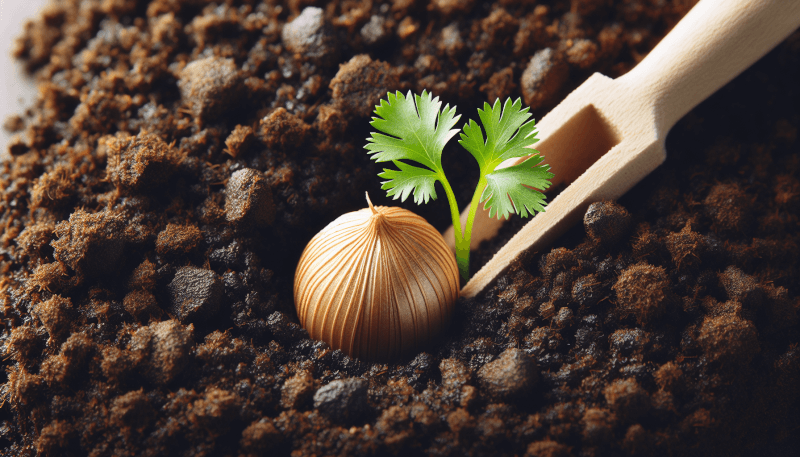Coriander seeds, also known as cilantro, are a versatile herb that can add a burst of flavor to your dishes. If you’ve always wanted to grow your own coriander, look no further! In this article, you’ll find simple and easy-to-follow steps on how to plant coriander seeds. Whether you have a backyard garden or a small pot on your windowsill, you’ll soon be enjoying the fresh, aromatic leaves in your cooking. So, gather your gardening tools and let’s get started on this exciting journey to grow your own coriander!
Selecting the Seeds
Buying high-quality seeds
When it comes to growing coriander, selecting high-quality seeds is essential. Look for seeds from reputable suppliers or nurseries that specialize in herb seeds. The seeds should be fresh, plump, and free from any signs of damage or decay. High-quality seeds will have a higher germination rate, ensuring a successful start to your coriander-growing journey.
Choosing the right variety
Coriander comes in different varieties, each with its unique flavor and characteristics. The two main types of coriander are cilantro and coriander seeds. Cilantro is the leafy herb used in cooking, while coriander seeds are the dried fruits that are commonly ground and used as a spice. Consider your preference and intended use when selecting the variety of coriander seeds to plant.
Checking the expiration date
Before purchasing coriander seeds, always check the expiration date on the packaging. Seeds that are past their expiration date may have a reduced germination rate, leading to disappointing results. Fresh seeds are more likely to sprout and grow into healthy plants, so be sure to choose seeds with a long shelf life or those that haven’t expired yet.
Preparing the Soil
Choosing the right location
Coriander plants thrive in full sun to partial shade, so it’s important to choose a location in your garden or balcony that receives adequate sunlight. Ensure the area is well-drained to prevent waterlogging, as coriander prefers slightly moist but not soggy soil. Additionally, consider proximity to a water source for easier watering in the future.
Testing the soil
Before planting coriander seeds, it’s helpful to test the soil’s pH level and nutrient content. Coriander prefers a slightly acidic to neutral soil pH between 6.2 and 6.8. You can use a home soil testing kit or consult a professional for a thorough analysis. Understanding your soil’s composition will allow you to make any necessary amendments to optimize the growth of your coriander plants.
Amending the soil
Based on the soil test results, you might need to make some amendments to ensure the soil is rich and fertile. Adding organic matter like compost, well-rotted manure, or aged leaf mulch can improve soil structure, fertility, and water-holding capacity. Incorporate the amendments into the soil before planting your coriander seeds to provide a nutrient-rich environment for the plants’ growth.
Sowing the Seeds
Selecting the planting method
Coriander seeds can be sown directly into the ground or started indoors in containers. If you have limited space or want to extend the growing season, starting the seeds indoors is a great option. Use seed trays or small pots filled with seed-starting mix, and transplant the seedlings outdoors once they have developed a few sets of true leaves. Alternatively, you can sow the seeds directly into the prepared soil outdoors.
Preparing the planting area
Regardless of the planting method you choose, proper preparation of the planting area is crucial. Ensure the soil is loose, well-drained, and free from weeds. Clear any debris or rocks that may obstruct root development. If sowing directly into the ground, create small furrows or rows where you will sow the coriander seeds.
Spacing the seeds
Coriander plants require adequate spacing to grow and thrive. When sowing the seeds, space them about 1 to 2 inches apart in rows or furrows. This spacing allows each plant to have enough space to develop without competing for nutrients and sunlight. If you’re planting in containers, only place one seed per pot to avoid overcrowding.
Caring for the Plants
Providing adequate water
Proper watering is essential for the successful growth of coriander plants. Water the soil consistently to keep it slightly moist but not overly saturated. Avoid allowing the soil to dry out completely between watering sessions, as this can cause stress to the plants and affect their growth. Regularly check the moisture level of the soil and adjust your watering schedule accordingly.
Applying fertilizer
To promote healthy plant growth and leaf development, it’s beneficial to apply fertilizer to your coriander plants. Use a balanced, slow-release fertilizer or organic compost around the base of the plants. Follow the manufacturer’s instructions for the appropriate amount and frequency of fertilizer application. Avoid over-fertilization, as it can lead to excessive foliage growth at the expense of seed production.
Managing weeds
Weeds can compete with coriander plants for nutrients, water, and sunlight, hindering their growth. Regularly inspect your coriander bed and remove any weeds by hand or using a small gardening tool. Be careful not to disturb the roots of the coriander plants in the process. Mulching around the plants can also help suppress weed growth and maintain soil moisture.
Protecting against Pests and Diseases
Identifying common pests
Coriander plants can be susceptible to certain pests, such as aphids, spider mites, and caterpillars. Regularly inspect your plants for any signs of pest infestation, including discolored leaves, holes, or webbing. Identifying pests early on allows you to take appropriate action and prevent further damage to your coriander plants.
Using organic pest control methods
When it comes to pest control, it’s best to choose organic methods to avoid chemical residues on your harvest. Introduce beneficial insects like ladybugs or lacewings that prey on pests. Additionally, you can create homemade organic sprays using ingredients like neem oil, garlic, or soap to deter and control pest populations. Regularly monitor your plants to ensure pests are kept under control.
Preventing diseases
Coriander plants are generally resilient and less prone to diseases. However, overwatering or poor air circulation can lead to fungal infections, such as powdery mildew or damping-off. To prevent these diseases, water the plants at the soil level and avoid splashing water on the foliage. Ensure proper spacing between plants to allow for good air circulation and promptly remove any infected leaves to prevent the spread of disease.
Harvesting the Plants
Determining the right time to harvest
Coriander leaves can be harvested when they reach around 6 inches in height. The leaves are most flavorful before the plants start flowering. If you’re growing coriander for the seeds, wait until the flowers turn into seed pods and start to dry out. The seeds should be brown and firm. Harvesting at the right time ensures optimal flavor and quality.
Harvesting the leaves
To harvest coriander leaves, simply use a sharp pair of scissors or garden pruners to cut off the desired amount of leaves. Cut the leaves close to the base of the plant, leaving a few inches of stem intact. This allows the plant to continue producing new leaves. Harvesting regularly encourages bushier growth and a continuous supply of fresh leaves.
Collecting the seeds
For harvesting coriander seeds, wait until the seed pods have dried out on the plant. Once dry, gently crush or rub the pods to release the seeds. Collect the seeds in a clean container, ensuring they are completely dry before storing or using them. Thoroughly dry seeds have a longer shelf life and retain their flavor and aroma.
Storing and Preserving Coriander Seeds
Drying the seeds
After collecting the coriander seeds, it’s important to dry them thoroughly before storing. Spread the seeds in a single layer on a clean, dry surface, such as a tray or a paper towel. Place them in a cool, well-ventilated area and allow them to air dry for about a week. Stir the seeds occasionally to ensure even drying.
Storing in airtight containers
Once the coriander seeds are fully dried, transfer them to airtight containers, such as glass jars or plastic bags. Ensure the containers are clean and dry to prevent moisture from affecting the seeds’ quality. Label the containers with the date of harvesting to keep track of their freshness. Store the containers in a cool, dark pantry or cupboard away from direct light and heat.
Freezing or grinding the seeds
If you have an abundance of coriander seeds, you can consider freezing or grinding them for long-term preservation. To freeze the seeds, place them in a freezer-safe bag or container and store them in the freezer. Grinding the seeds into a fine powder allows you to use them as a spice in various recipes. Use a spice grinder or mortar and pestle to grind the seeds to your desired consistency.
Common Mistakes to Avoid
Overwatering the plants
One common mistake when growing coriander is overwatering the plants. Coriander prefers slightly moist soil, but excessive watering can lead to root rot and poor plant growth. It’s essential to monitor the moisture level of the soil and water accordingly. Allow the soil to dry out slightly between watering sessions to prevent waterlogged conditions.
Planting in compacted soil
Coriander plants have delicate, shallow roots that can struggle to penetrate compacted soil. Avoid planting coriander in soil that is heavy, clayey, or compacted. These conditions can hinder root development and limit nutrient uptake. Ensure the soil is loose, well-drained, and adequately amended to provide an optimal growing environment for your coriander plants.
Disregarding sunlight requirements
Coriander plants thrive in full sun to partial shade. While they can tolerate some shade, insufficient sunlight can result in leggy and weak growth. Ensure you choose a planting location that receives at least 4-6 hours of direct sunlight per day. Without adequate sunlight, the plants may fail to reach their full potential and may become more susceptible to diseases.
FAQs
How long does it take for coriander seeds to germinate?
Coriander seeds typically germinate within 7 to 10 days under ideal conditions. Factors such as temperature, moisture, and seed quality can influence germination time. Providing consistent moisture and a temperature range between 60°F and 75°F will help ensure successful germination.
Can coriander be grown in pots?
Yes, coriander can be successfully grown in pots or containers. Choose a container that is at least 8 inches deep to accommodate the coriander’s shallow root system. Ensure the container has drainage holes to prevent waterlogging. Place the pot in a sunny location and provide regular watering and fertilization to support healthy growth.
How often should coriander be watered?
Coriander plants should be watered whenever the top inch of soil feels dry to the touch. This can range from once every 2 to 3 days, depending on the temperature and humidity levels. Avoid overwatering, as it can lead to root rot. Aim for consistent moisture without saturating the soil excessively.
Conclusion
Enjoying the satisfaction of growing your own coriander at home is a rewarding experience. By selecting high-quality seeds, preparing the soil, sowing the seeds, and providing proper care, you can cultivate a bountiful crop of coriander. From harvesting the leaves and collecting the seeds to storing and preserving them, you’ll have a fresh supply of aromatic coriander for your culinary creations. Share the joy of homegrown coriander by experimenting with new recipes and sharing your harvest with friends and family. Happy gardening!




